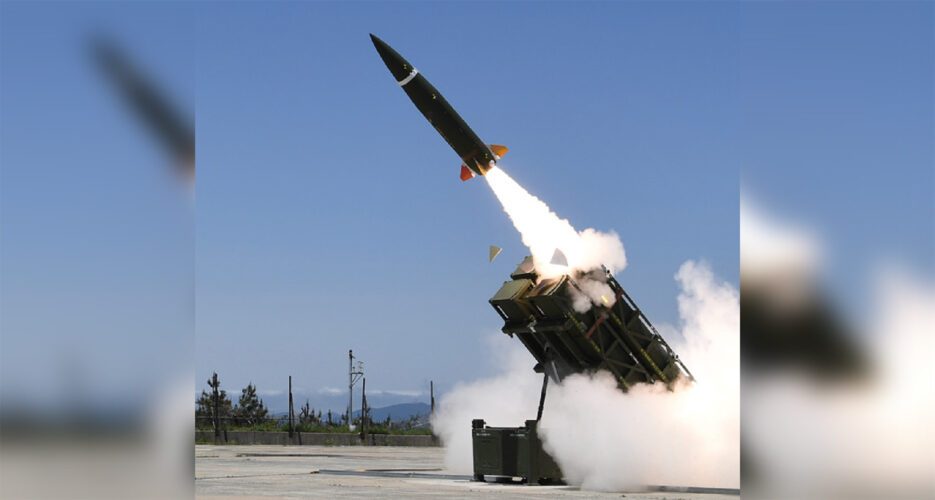South Korea tests precision missile aimed at countering North Korean artillery
ROK military says launch paves way for mass production of tactical missile, even as development continues on upgrade

South Korea has conducted a live-fire test of a homegrown tactical guided missile designed to counter artillery threats from enemies such as North Korea, according to the ROK military, paving the way for the weapon to enter full-scale mass production later this year.
The Defense Agency for Technology and Quality (DTAQ) successfully conducted the quality certification test of the Korean Tactical Surface-to-Surface Missile (KTSSM) on Thursday morning KST at a facility operated by the state-owned Agency for Defense Development, the Defense Acquisition Program Administration stated in a press release.
South Korea last reported a projectile launch in late December, when it tested a homegrown solid-propellant space launch vehicle aimed at augmenting space-based reconnaissance capabilities.
The system, developed between 2014 and 2019 by South Korean defense firm Hanwha, reportedly has a range of up to 180 km and a caliber of 400mm, and is aimed at delivering precision strikes against an enemy’s long-range artillery.
“The KTSSM is the best precision strike surface-to-surface guided weapon that has entered the mass production stage in South Korea,” DTAQ head Jang Bong-gi said after the test.
Ankit Panda, Stanton Senior Fellow in the Nuclear Policy Program at the Carnegie Endowment for International Peace, told NK News that the missile will be “an important part of the ROK army’s overall strike posture.”
 A test of the KTSSM during its initial development phase in 2017 | Image: ROK Ministry of National Defense YouTube (July 29, 2017)
A test of the KTSSM during its initial development phase in 2017 | Image: ROK Ministry of National Defense YouTube (July 29, 2017)
The new missile, which is said to bear outward similarities to the U.S.-made Army Tactical Missile System (ATACMS) surface-to-surface missile but has lower range and caliber, could offer significant advantages for the South Korean military’s defenses against North Korea.
“It is expected to contribute to eliminating or reducing threats to Seoul and other metropolitan areas in that it can quickly strike mine turrets and new tactical ballistic missiles deployed in North Korea’s frontline military zone, in case of emergency,” Shin Seung-ki, a research fellow at Seoul’s Korea Institute for Defense Analyses (KIDA), told NK News.
Describing the KTSSM as “the most rapidly operated precision-guided weapon” among the ROK military’s current arsenal of tactical ballistic missiles, he said that it can be fired from a launch tube immediately to strike and neutralize a target within minutes.
Uzi Rubin, a senior researcher at Israel’s Begin-Sadat Center for Strategic Studies, offered a similar assessment of the weapon’s main purpose in the event of a conflict with North Korea.
“This is a precision battlefield missile, which is extremely useful for taking out high value point targets like command centers, air defense batteries or ammunition dumps,” he said.
“It is equivalent to the U.S. HIMARS, which is doing such a good job in Ukraine,” he added.
ROK’s defense development agencies also seek to build on the success of the new test, and its roll-out focused on developing the missile’s recently announced successor, KTSSM-II.
The KTSSM-II, expected to be developed by 2030, will feature an expanded range of 300 km and is likely to be larger than the missile’s first generation, according to South Korean media.
This range makes the Block II variant a more direct analog to the U.S. ATACMS system, according to the Carnegie Endowment’s Panda.
Shin of KIDA said the KTSSM and KTSSM-II systems are expected to have the same accuracy but that the upgraded version will be more powerful.
“The destructive power is expected to increase as the range increases significantly and the size of the warhead increases,” he said, adding that the second-generation missile’s heavier weight will likely increase its ability to penetrate underground.
North Korea has not responded to the announcement of the ROK missile launch as of Friday morning. The DPRK last tested a ballistic missile on April 13, launching its new solid-fuel Hwasong-18 long-range missile.
Edited by Bryan Betts
Source:nknews.org/